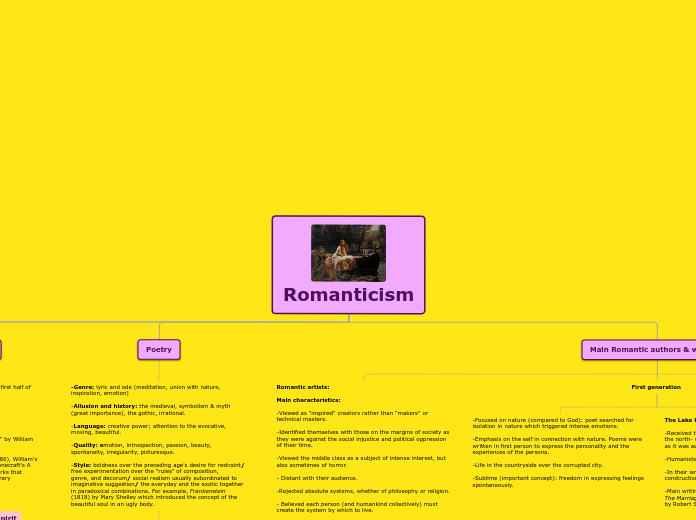Romanticism
Main Romantic authors & writings
Second generation
- They were mostly attracted to the problems related to life and art.
-Against society viewed as corrupted.
-Rejected the real world and, thus, created a different one.
-They used to travel trying to escape from society.
-Main writings: Frankenstein by Shelley; Ode to a Nightingale by John Keat; Don Juan by George Byron.
George Gordon Byron (1788- 1824)
Percey Bysshe Shelley (1792- 1822)
John Keats (1795- 1821)
First generation
The Lake Poets:
-Received that name since they all lived in the Lake District in the north- west of England. They were attracted to such place as it was away from industry.
-Humanists. They urged to go back to nature.
-In their writings, they used short forceful words and constructions of everyday speech.
-Main writings: Lyrical Ballads by Wordsworth and Coleridge; The Marriage of Heaven and Hell by Blake; The Life of Nelson by Robert Southey.
William Wordsworth (1770- 1850)
Samuel Taylor Coleridge (1772- 1834)
Robert Southey (1774- 1843)
-Focused on nature (compared to God): poet searched for isolation in nature which triggered intense emotions.
-Emphasis on the self in connection with nature. Poems were written in first person to express the personality and the experiences of the persona.
-Life in the countryside over the corrupted city.
-Sublime (important concept): freedom in expressing feelings spontaneously.
Romantic artists:
Main characteristics:
-Viewed as "inspired" creators rather than "makers" or technical masters.
-Identified themselves with those on the margins of society as they were against the social injustice and political oppression of their time.
-Viewed the middle class as a subject of intense interest, but also sometimes of horror.
- Distant with their audience.
-Rejected absolute systems, whether of philosophy or religion.
- Believed each person (and humankind collectively) must create the system by which to live.
Poetry
-Genre: lyric and ode (meditation, union with nature, inspiration, emotion)
-Allusion and history: the medieval, symbolism & myth (great importance), the gothic, irrational.
-Language: creative power; attention to the evocative, moving, beautiful.
-Quality: emotion, introspection, passion, beauty, spontaneity, irregularity, picturesque.
-Style: boldness over the preceding age's desire for restraint/ free experimentation over the "rules" of composition, genre, and decorum/ social realism usually subordinated to imaginative suggestion/ the everyday and the exotic together in paradoxical combinations. For example, Frankenstein (1818) by Mary Shelley which introduced the concept of the beautiful soul in an ugly body.
Main topics
Emotions, intuition, instincts, feelings & imagination: key for creating art.
- The purpose of literature was not to describe the world as it was, but rather as how it could be.
Nature: a work of art, wild & untamable
- A product of the imagination, distinct from, but related to, the entities that existed in the physical world.
For different Romantic artists, nature could be:
• A subject or an image
• A healing power
• The dwelling place for the divine
• A refuge from the harshness of civilization and the industrialized world
The individual:
- Emphasis on intuition, instinct, emotion, reason and logic.
- Only under conditions of solitude, people can be most sensitive to the world around us.
- The speaker in any romantic poem is positioned as a heroic outsider operating independently from the society of which he is part.
Glorification of the past:
- Memory is at the center of the individual process of reflection.
Belief in children’s innocence and wisdom:
-Youth as a golden age; adulthood as corruption and betrayal.
Where did all begin?
From the second half of the XVIII century to the first half of the XIX century.
The Romantic period is said to have begun:
- In 1798 with the publication of "Lyrical Ballads" by William Wordsworth and Samuel Coleridge.
- At around 1785 with Robert Burns's Poems (1786), William's Blake "Songs of Innocence" (1789), Mary Wollstonecraft's A Vindication of the Rights of Women and other works that showed a change in the political thought and literary expression.
The spread of the Romantic spirit
Literature & all types of arts: from music (considered the rise of Romantic opera) to painting, from sculpture to architecture.
Eastward to Russia and westward to America.
Definition

